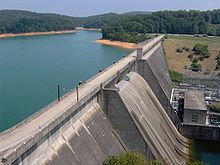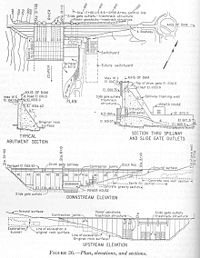- Norris Dam
-
Norris Dam 
Norris DamOfficial name Norris Dam Location Anderson County and Campbell County, Tennessee, USA Coordinates 36°13′27″N 84°05′29″W / 36.22417°N 84.09139°WCoordinates: 36°13′27″N 84°05′29″W / 36.22417°N 84.09139°W Construction began October 1, 1933 Opening date March 4, 1936 Dam and spillways Height 265 feet (81 m) Length 1,860 feet (570 m) Impounds Clinch River Reservoir Creates Norris Lake Power station Turbines 2 Installed capacity 131.4 MW Norris Dam is a hydroelectric and flood control structure located on the Clinch River in Anderson County and Campbell County, Tennessee, USA. Its construction in the mid-1930s was the first major project for the Tennessee Valley Authority, which had been created in 1933 to bring economic development to the region and control the rampant flooding that had long plagued the Tennessee Valley. The dam was named in honor of Nebraska Senator George Norris (1861-1944), a longtime supporter of government-owned power in general, and supporter of TVA in particular.[1]
Norris Dam is a straight concrete gravity-type dam. The dam is 1860 feet (570 m) long and 265 feet (81 m) high. Norris Lake, the largest reservoir on a tributary of the Tennessee River, has 33,840 acres (137 km²) of water surface and 809 miles (1302 km) of shoreline. The dam has a maximum generating capacity of 131,400 kilowatts.[2]
Contents
Location
The Clinch River flows southwestward for 300 miles (480 km) from its headwaters in Virginia through the rugged, sparsely-populated hills of northeastern Tennessee before emptying into the Tennessee River near Kingston. Norris Dam is located at just over 79 miles (127 km) upstream from the mouth of the Clinch, immediately downstream from the river's confluence with Cove Creek, which joins the river from the northwest. The reservoir includes parts of Anderson, Campbell, Union, Claiborne, and Grainger counties. Norris Reservoir spans a 73-mile (117 km) stretch of the Clinch from the dam to River Ridge at the Claiborne-Grainger county line. The reservoir also covers the lower 56 miles (90 km) of the Powell River, which empties into the Clinch 10 miles (16 km) upstream from Norris Dam. The dam's tailwaters are part of Melton Hill Lake, which stretches for 56 miles (90 km) along the Clinch from Norris to Melton Hill Dam.
Norris Freeway, a section of U.S. Highway 441 widened in the 1930s to aide in dam construction, crosses the top of Norris Dam and connects the area to Interstate 75 at Lake City, Tennessee to the west and Knoxville to the south. Along with the reservation maintained by TVA for the operation of Norris Dam, most of the lower Norris Reservoir is surrounded by conservation lands, including Norris Dam State Park adjacent to the reservation, the Cove Creek Wildlife Management Area across the lake to the north, and the Chuck Swan State Forest, which protects a large undeveloped area a few miles upstream.
Background and construction
As early as 1911, the present site of Norris Dam— initially called the "Cove Creek site"— was identified as a prime location for a sizeable dam. Several government and private entities believed that a dam in the upper Tennessee Valley, working in conjunction with dams at Muscle Shoals, Alabama, could provide badly needed flood control to East Tennessee and help keep the Tennessee River consistently navigable year-round. In the early 1920s, several entities— including the Tennessee Electric Power Company (TEPCo), the Knoxville Power & Light Company, and Union Carbide— applied for permits to build a dam at the Cove Creek site, although all were eventually withdrawn or rejected. Part of the opposition was from Senator Norris, who advocated a government-sponsored dam at the site, arguing that a private entity would be almost wholly concerned with power generation rather than flood control and coordination with projects elsewhere in the valley. Norris proposed constructing a network of dams throughout the valley to help regulate its outflow into the lower Mississippi River. Throughout the late 1920s, the U.S. Army Corps of Engineers made several proposals to build a dam at the site, but all were rejected by Congress or vetoed by President Calvin Coolidge.[1]
The Tennessee Valley Authority was formed in 1933 as part of President Franklin D. Roosevelt's New Deal legislation. The act authorizing TVA's establishment (signed on May 18, 1933) authorized TVA to immediately begin construction on a dam at the Cove Creek site. On July 30, TVA renamed the Cove Creek project for Senator Norris and began preparations for the dam's construction. As the agency lacked any engineering or dam construction experience, it relied heavily on the Army Corps' original design, and received ample consulting from the U.S. Bureau of Reclamation.[1] Hungarian-American architect Roland Wank (1898-1970) revised the initial plans from Bureau of Reclamation engineers, and gave the poured-concrete Norris Dam a modernist style, which was controversial and advanced for the era of construction, but the result would eventually succeed in elevating Roland Wank to the position of Chief Architect for TVA from 1933 through 1944.[3] Construction began on October 1, 1933.
The building of Norris Dam and its accompanying reservoir required the purchase of over 152,000 acres (62,000 ha) of land. 2,841 families and 5,226 graves were relocated. The community of Loyston, located about 20 miles (32 km) upstream from the dam site, was entirely inundated. Approximately one-third of Caryville, at the head of the reservoir's Cove Creek embayment, was flooded and a number of structures in the town had to be moved. Several smaller 30-foot (9.1 m) earthen dams were built along reservoir tributaries to house fish hatcheries. As the project called for the construction of recreational areas along the lakeshore, TVA built two supplemental dams— Caryville Dam and Big Ridge Dam— to impound Cove Lake and Big Ridge Lake, respectively, and ensure these small lakes would remain filled year-round. The Civilian Conservation Corps built recreational facilities and aided in the removal of various structures.[1] The town of Norris, Tennessee was initially built as a planned community to house the workers involved in the construction of this dam.[4]
Norris Dam was completed and the gates closed on March 4, 1936, constructed at a cost of $36 million. The dam's first generator went online July 28, 1936. Although Norris was the first dam built by TVA, it is not the oldest dam owned and operated by the agency. TVA subsequently purchased the assets of the former Tennessee Electric Power Company, including some dams which had been built prior to Norris Dam. The building of Norris Dam and the changes it brought to the region inspired films, books, stage plays, and songs. Folk songs from the construction period express enthusiasm for the benefits that the dam project brought to the region.[1][5]
References
- ^ a b c d e Tennessee Valley Authority, The Norris Project: A Comprehensive Report on the Planning, Design, Construction, and Initial Operations of the Tennessee Valley Authority's First Water Control Project, Technical Report No. 1 (Washington, D.C.: U.S. Government Printing Office, 1940), pp. 1-12, 46-47, 65, 531.
- ^ Tennessee Valley Authority, Norris Reservoir. Retrieved: 9 January 2009.
- ^ TVA — Design for the Public Good. Retrieved: 9 January 2009.
- ^ The Planned Community of Norris, Tennessee. Retrieved: 9 January 2009.
- ^ Bob Fulcher, "The Songs of Norris Dam", The Tennessee Conservationist, July 2000.
External links
- Norris Reservoir — official TVA site
- "Slopes of Norris Dam Rising to Tame a River" Popular Mechanics, October 1935
- Norris Dam at Structurae
- Images of Norris Dam at Norris Lake, TN
- Photo Gallery, Norris Dam, TN at New Deal Network
- Norris Reservoir — Tennessee Wildlife Resources Agency fishing information for Norris Reservoir
- Map of Norris Reservoir
Facilities operated by the Tennessee Valley Authority Dams and hydroelectric
generating stationsApalachia · Bear Creek · Beaver Creek · Beech · Blue Ridge · Boone · Cedar · Cedar Creek · Chatuge · Cherokee · Chickamauga · Clear Creek · Dogwood · Douglas · Fontana · Fort Loudoun · Fort Patrick Henry · Great Falls · Guntersville · Hiwassee · Kentucky · Little Bear Creek · Lost Creek · Melton Hill · Nickajack · Nolichucky · Normandy · Norris · Nottely · Ocoee 1 · Ocoee 2 · Ocoee 3 · Pickwick Landing · Pin Oak · Pine · Raccoon Mountain · Redbud · South Holston · Sycamore · Tellico · Tims Ford · Upper Bear Creek · Watauga · Watts Bar · Wheeler · Wilbur · Wilson
Coal-fired power plants Allen · Bull Run · Colbert · Cumberland · Gallatin · John Sevier · Johnsonville · Kingston · Paradise · Shawnee · Widows CreekCombustion turbine plants Caledonia · Gleason · Kemper · Lagoon Creek · MarshallNuclear power plants Categories:- Dams in Tennessee
- New Deal
- Buildings and structures in Anderson County, Tennessee
- Buildings and structures in Campbell County, Tennessee
- Tennessee Valley Authority
- Hydroelectric power plants in Tennessee
- Historic Civil Engineering Landmarks
Wikimedia Foundation. 2010.

